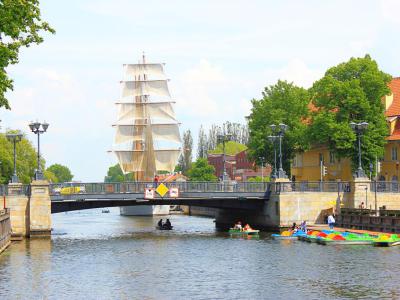
Birzos Tiltas (Exchange Bridge), Klaipeda
The Exchange Bridge spans gracefully over the Danė River, connecting Herkaus Mantos and Tiltė streets. This steel swing bridge, with a distinctive ability to raise at an angle of 50 degrees on both sides, holds a significant place in the cultural heritage of the Republic of Lithuania as it is included in the register of immovable cultural values.
The history of Exchange Bridge dates back to the 18th century when a wooden bridge, bearing strategic importance, stood in its place. Protected by a poured ravelin on the right bank, the bridge was a source of considerable income for the city. Passing ships were required to pay a bridge lifting fee, and a small opening in the middle of the bridge allowed the masts of sailing ships to pass through. Until the 19th century, it served as the sole transit bridge, undergoing numerous reconstructions and enhancements.
In 1877, under the architectural guidance of local architect Meyer and engineer Bernstein from Wiesbaden, construction commenced on a new swinging metal bridge supported by brick foundations. The Gdańsk firm responsible for its construction completed the bridge in 1879, featuring two openings – 19 and 14 meters wide. The advent of trams in 1904 prompted another round of reconstruction, adding intricate Art Nouveau-style metal portals adorned with lanterns. Metal elbow structures were strategically placed to prevent bending of the movable bridge sections.
Throughout the 20th century, Exchange Bridge underwent various modifications, including the removal of portals and simplification of railings. Sadly, the bridge suffered destruction during World War II. In 1948, a reconstruction effort breathed new life into the structure, and further restoration occurred in 2006-2007, ensuring the continued presence and functionality of this historic landmark in Klaipėda.
The history of Exchange Bridge dates back to the 18th century when a wooden bridge, bearing strategic importance, stood in its place. Protected by a poured ravelin on the right bank, the bridge was a source of considerable income for the city. Passing ships were required to pay a bridge lifting fee, and a small opening in the middle of the bridge allowed the masts of sailing ships to pass through. Until the 19th century, it served as the sole transit bridge, undergoing numerous reconstructions and enhancements.
In 1877, under the architectural guidance of local architect Meyer and engineer Bernstein from Wiesbaden, construction commenced on a new swinging metal bridge supported by brick foundations. The Gdańsk firm responsible for its construction completed the bridge in 1879, featuring two openings – 19 and 14 meters wide. The advent of trams in 1904 prompted another round of reconstruction, adding intricate Art Nouveau-style metal portals adorned with lanterns. Metal elbow structures were strategically placed to prevent bending of the movable bridge sections.
Throughout the 20th century, Exchange Bridge underwent various modifications, including the removal of portals and simplification of railings. Sadly, the bridge suffered destruction during World War II. In 1948, a reconstruction effort breathed new life into the structure, and further restoration occurred in 2006-2007, ensuring the continued presence and functionality of this historic landmark in Klaipėda.
Want to visit this sight? Check out these Self-Guided Walking Tours in Klaipeda. Alternatively, you can download the mobile app "GPSmyCity: Walks in 1K+ Cities" from Apple App Store or Google Play Store. The app turns your mobile device to a personal tour guide and it works offline, so no data plan is needed when traveling abroad.
Birzos Tiltas (Exchange Bridge) on Map






Sight Name: Birzos Tiltas (Exchange Bridge)
Sight Location: Klaipeda, Lithuania (See walking tours in Klaipeda)
Sight Type: Attraction/Landmark
Guide(s) Containing This Sight:
Sight Location: Klaipeda, Lithuania (See walking tours in Klaipeda)
Sight Type: Attraction/Landmark
Guide(s) Containing This Sight:
Walking Tours in Klaipeda, Lithuania
Create Your Own Walk in Klaipeda
Creating your own self-guided walk in Klaipeda is easy and fun. Choose the city attractions that you want to see and a walk route map will be created just for you. You can even set your hotel as the start point of the walk.
Klaipeda Introduction Walking Tour
Welcome to Klaipeda, a captivating city on the Baltic Sea coast of Lithuania! Despite being the country's third-largest city, Klaipeda often escapes the attention of tourists who might only stop by briefly before heading straight to the sea and sand dunes of the Curonian Spit.
The city has a complex history, partially due to the strategic importance of its ice-free port at the mouth of... view more
Tour Duration: 2 Hour(s)
Travel Distance: 3.4 Km or 2.1 Miles
The city has a complex history, partially due to the strategic importance of its ice-free port at the mouth of... view more
Tour Duration: 2 Hour(s)
Travel Distance: 3.4 Km or 2.1 Miles
Klaipeda Statues and Monuments Walk
Founded by Germans in the mid-13th century, Klaipeda is the oldest city in Lithuania and quite big on historical and artistic heritage. The latter includes numerous statues and monuments, some of which are weird, some outstanding, and some simply amusing, collectively adding a great deal of charm to the city's cultural scene.
A notable location to find a wealth of sculptures in one place... view more
Tour Duration: 2 Hour(s)
Travel Distance: 2.8 Km or 1.7 Miles
A notable location to find a wealth of sculptures in one place... view more
Tour Duration: 2 Hour(s)
Travel Distance: 2.8 Km or 1.7 Miles


